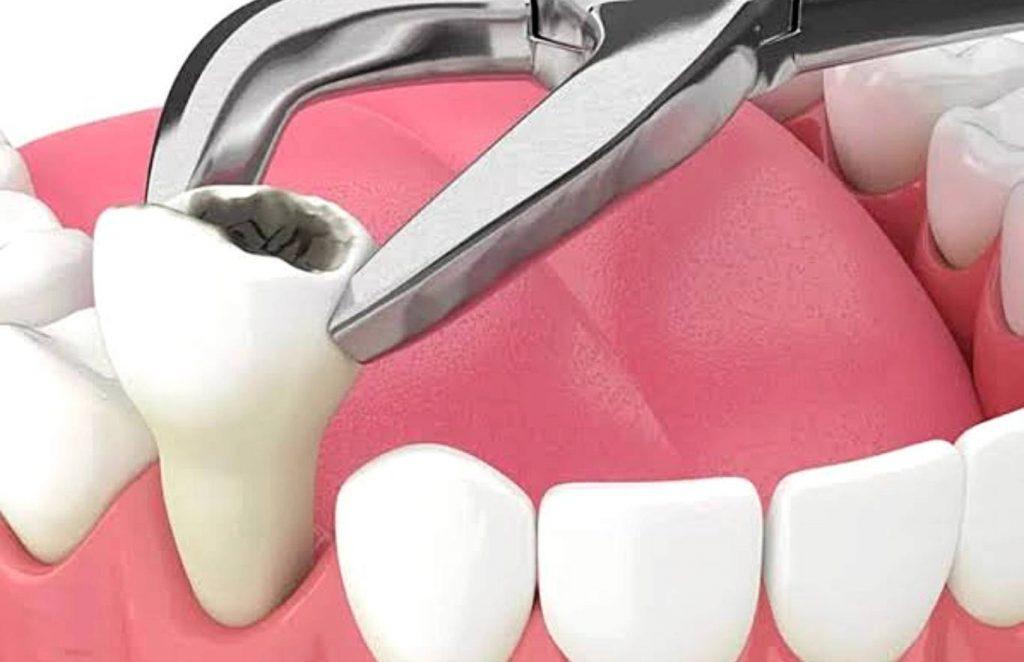Introduction:

All vital information concerning smoking after tooth extraction with gauze, are covered in this article. This content has been reviewed by our medical authors and it’s 100% safe for you to follow.
Due to the obvious suctioning or sucking motion used to pull smoke from the cigarette, smoking can induce dry socket.
This motion has the potential to shift the blood clot that develops over the treated area. When the blood clot dissolves, the bone underneath the extraction site is exposed, resulting in intense discomfort and a delay in recovery.
It is essential to consider that some lifestyle choices and habits may need to be modified during the rehabilitation process.
This involves quitting smoking and refraining from vaping. Heat, tar, and other substances injected into your mouth might irritate the healing tissues significantly. Please read on to learn more on smoking after tooth extraction with gauze.
Smoking After Tooth Extraction With Gauze

After a tooth extraction with gauze, you should not smoke for at least 48 to 72 hours, and you should check with your dentist to see how long you should wait.
Your dentist may recommend that you apply sterile gauze to the area where the tooth was extracted.
It keeps some smoke out of your eye and relieves pressure on the area, making the blood clot less likely to dislodge and result in a dry socket. When you reintroduce smoking, it’s essential to use gauze to relieve the pressure on your eyes.
Can I Smoke After Tooth Extraction If I Cover It?
The simple truth is that you cannot smoke following a tooth extraction. Your dentist or oral surgeon will highly advise you not to smoke or engage in any other sucking behavior for at least 72 hours following your tooth extraction.
Tooth extraction can be very challenging sometimes. If your dentist recommends that you have a tooth pulled for one of several reasons, your dentist will advise you to stop smoking for a period of time following the treatment.
It might be difficult for a frequent smoker to quit smoking for a short period of time. However, it is strongly advised that you follow your dentist’s instructions.
If I Smoke, Will I Surely Have A Dry Socket?
Tobacco and smoking should be avoided.
According to one study, 12 percent of those who smoked following tooth extraction experienced dry socket. In comparison, just 4% of nonsmokers experienced dry sockets. Smoking’s rapid intake might dislodge a blood clot.
If you’re recovering from dental surgery or want to kick-start a smoking cessation program, an app might assist.
Your dentist may also be able to give materials or assist you in developing a smoking cessation strategy. Reduce your cigarette consumption for a few weeks before a scheduled dental procedure.
Is It Okay For Me To Smoke 12 Hours Following A Tooth Extraction?

The first set of rules is to stop smoking for at least 24 hours. If the sucking motion dislodges the clot, you’ll be back at square one.
A painful condition known as a dry socket will develop if the clot is removed. This is not something you want to go through.
Tobacco products have been shown to be toxic to a tooth extraction site and can increase the risk of bleeding. Smoking can also cause infections and make the healing process take longer.
Healing will be delayed as a result of the tooth’s reduced blood flow, according to the American Dental Association.
Why Do Dry Sockets Occur As A Result Of Smoking?
When you smoke, the sucking feeling from the cigarettes might draw the blood clot out of the socket.
This exposes the nerves, making them susceptible to infection. A dry socket and extreme discomfort might result from an infection, which can persist up to a week.
An alveolar osteitis, also known as a dry socket, is a painful condition that occurs when a tooth is extracted.
When a tooth is extracted, a socket is left in the bone, which is effectively a little hole. This surgery area’s natural healing process is crucial. Please follow your dentist’s instructions.
When Is The Risk Of Dry Socket Highest?
The risk for this disorder is greatest between days 2-3 after tooth extraction. The risk of dry socket has passed after day four.
This problem occurs rarely (approximately 4% of all extractions) and is most common following bottom wisdom teeth extraction.
Severe occurrences of this ailment frequently develop on the first day following surgery and must be handled by your dentist. However, mild instances can be treated at home and may disappear on their own within a few days.
Which Teeth Are Most Likely To Have Dry Socket?

When a tooth is extracted, dry socket can occur anywhere from 2% to 5% of the time. This disorder affects mandibular teeth more frequently than maxillary teeth.
Dry socket is most frequent after molar extractions, particularly wisdom teeth, when it can occur up to 30% of the time.
If dry socket is detected, the patient should be urged to see a dentist or oral surgeon as soon as possible.
A few days after the tooth is extracted, patients with this ailment often endure a constant throbbing ache.
Food debris frequently accumulates in the unfilled socket, contributing to the problem. Pain usually goes away immediately once treatment is given.
Is Gauze Effective In Preventing Dry Socket?
The American Dental Association recommends covering the extraction spot with gauze for 30 to 45 minutes after the treatment. This promotes the formation of a blood clot and can help avoid dry socket.
If you smoke, you may request an oxidized cellulose dental dressing to aid in the prevention of dry socket.
You should be very careful with your mouth until the wound has healed completely. Chew on the opposite side of your mouth from where you extracted.
Another Reading Suggestion
Can A Salt Water Rinse Help To Avoid Dry Socket?
Touching the extraction site with your fingers or tongue might cause the clotting to break down.
After tooth extraction, gently washing with salt water twice a day can help keep the area surrounding your socket clean.
Dry socket can also be caused by certain activities such as smoking and drinking with a straw. To help avoid dry socket, follow your dentist guidelines.
How Can I Tell If I Have A Dry Socket?

The following are some of the signs and symptoms of dry socket: Within a few days, a tooth extraction causes intense pain.
A blood clot is lost at the site of tooth extraction, resulting in an empty (dry) socket. The socket contains visible bone.
Here Are Some Further Details:
- Pain that started at the treated area but expanded throughout your mouth.
- Due to the obvious dislodged blood clot, there is a big hole on the removal site.
- Poor socket odor and bad breath that won’t go away no matter how many times you clean your teeth.
- Pain that persists after a week following tooth extraction.
- A bad taste in the mouth.
Can You Smoke While Wearing Dry Socket Dressing?
You must not smoke. Smoking causes the same pressure in the mouth as drinking through a straw.
While it is recommended to avoid smoking throughout the healing process, it is especially important not to smoke during the first few days when the blood clot develops.
It is not suggested to smoke anything until the wound has healed fully. Smoking constricts blood vessels, delaying healing.
Try to avoid eating on that side of your mouth for two to three days. Do not touch or examine the empty socket.
Will Gauze Help To Break Up Blood Clots?
Do not remove the gauze until it has been absorbed with blood and saliva. Removing a little damp gauze from over an extraction site might cause the forming clot to fall out of the socket.
Which, in return, might result in a dry socket, which is a painful infection of the tooth socket. Waiting at least 20 minutes before removing the gauze will prevent the clot from attaching to it.
How Can I Tell Whether I’ve Displaced A Blood Clot?

Once you dislodge a wisdom teeth blood clot, you will either notice the clot in your mouth or the socket may bleed again.
When you acquire dry sockets, the discomfort indicates that your wound is not fully protected.
Swelling, as well as the taste of blood in your mouth, are signs that you have lost your blood clot.
How Simple Is It To Get A Blood Clot Out Of Your Mouth?
The sucking movement and the power used while spitting can both remove a blood clot. A blood clot can be dislodged by sneezing or coughing.
Foods that are hard or crunchy might displace the blood clot. Sticky foods have the potential to rip the protecting clot straight out of the socket.
The initial 24 to 48 hours following surgery are essential for the development of a dry socket. A dry socket can occur at any point within the first 7 days following surgery.
The dentist will clean the socket, remove any debris, and then apply a medicated dressing to the socket.
Can I Sip Water While Wearing Gauze In My Mouth?
It is not advised to do so. The gauze pad should be left over the surgery area for around 45 minutes, or until you have something soft to eat/drink, such as a milkshake or smoothie.
You may remove the gauze to eat or drink, and then return it as needed when finished.
Drinking water normally helps maintain your teeth clean and bacteria-free while also keeping your body hydrated. After your tooth extraction, drink plenty of water to keep the extraction site clean and avoid infection.
Can I Drink Coffee After Having A Tooth Extracted?

To allow your mouth to recover correctly, you should avoid drinking your favorite cup of coffee for at least the first several days.
You’ll be allowed to delicately sip a caffeinated beverage approximately 5 days after your tooth has been extracted as long as the extraction site heals day by day.
If everything goes well, any swelling should go away within two weeks and your mouth should be mostly healed. You can then resume drinking your usual amount of coffee.
Please consult your oral surgeon if anything seems wrong or if you encounter discomfort when you resume your usual coffee habits.
Another Reading Suggestion
Can I Eat While Wearing Gauze?
Before putting the gauze in your mouth, moisten it and wring it out. Only use gauze in your mouth until the bleeding stops. Before drinking or eating, the gauze should be removed.
It is not advisable to sleep with the gauze in your mouth. Pay close attention to gauze placement, making sure it covers the surgical site rather than just the space between the teeth.
When May I Smoke Without Being Concerned About Dry Sockets?
You might not be able to tell when you’re entirely healed, so be cautious. Avoid smoking for 24 hours after surgery. Stay away from consuming nuts, seeds, and crunchy foods that can become lodged in the socket.
Before smoking again, you should ideally wait 72 hours or three full days following tooth extraction.
Smoking less than 72 hours increases your chances of developing dry socket and other issues like increased pain, infection, and delayed recovery.
Is Dry Socket Frequent Among Smokers?

Smoking is another main cause of dry socket. In fact, smokers are 13% more likely to have dry sockets — more than double the risk of nonsmokers.
This includes smoking everything, not just cigarettes. Tobacco, on the other hand, may hinder the healing process.
Smoking’s rapid intake might dislodge a blood clot. This applies to any type of smoking, not just cigarettes. This is due to the fact that chemicals in other tobacco products may inhibit healing and induce infection.
What If I Smoke After Having A Tooth Extracted?
A patient who smokes after a tooth extraction risks slowing recovery and perhaps triggering inflammation and dry sockets.
Dry sockets can cause poor breath, trouble opening the mouth, and worsening discomfort. They can also spread and cause much more harm.
Smoking shortly following a tooth extraction may produce blood clots in the mouth, delaying recovery.
This can result in the establishment of a dry socket, therefore wait at least 72 hours before smoking again. Allow yourself time to recuperate in order to prevent getting new oral health concerns as a result of smoking.
Reduce your cigarette consumption for a few weeks before a scheduled dental surgery. If you are recovering from dental surgery or wish to start a smoking cessation program, an app may assist you avoid smoking.
Will Vaping Result In Dry Socket?
In terms of dry socket, vaping involves the same sucking motion as smoking in order to get the smoke from the e-cigarette into your lungs.
This means that vaping is just as likely as smoking to induce dry socket.
Patients should be encouraged not to smoke or use e-cigarettes following dental treatments, especially if bone grafting, sinus lift, or extractions were performed.
Drawing on a vaping device creates negative pressure, which can drive the clot away from the extraction site and induce dry socket.
Is Dry Socket Discomfort Felt Right Away?

When you have a dry socket, the discomfort generally starts one to 3 days after your tooth is extracted.
The most frequent complication following tooth extractions, such as the removal of third molars, is dry socket (wisdom teeth). Take note that dry socket pain cannot be treated with over-the-counter medicines alone.
The underlying bone and nerves are exposed, causing severe pain not only in the socket but also along the nerves extending to the side of your face.
The socket becomes irritated and may get clogged with food particles, worsening the discomfort. A blood clot is most commonly found at the site of a tooth extraction.
How Horrible Is Dry Socket?
Extreme discomfort is the most common symptom of dry socket. However, pain tolerance and perceptions differ from person to person.
As a result, some people may feel less discomfort than others. Dry socket is often diagnosed by a dentist based on the existence of discomfort and the dissolution of the clot following tooth extraction.
Since the primary therapy for dry sockets is pain control, the disease does not require treatment if it causes little or no discomfort.
Even if the infected area is not painful, anyone experiencing symptoms of an infection, such as pus from the socket, should seek medical attention.
How Can I Hasten The Healing Of My Tooth Extraction?
-
Do Not Use A Straw Or Smoke
Drinking via a straw or smoking causes negative tension in your mouth, which might remove a blood clot that has formed in the socket of your tooth. Dry sockets can cause serious infections, jaw bone deterioration, and nerve damage.
-
Relax
Relaxing with your head raised on a pillow can help you control post-surgical edema and bleeding.
This helps lymph and blood to move away from the treated area, which reduces inflammation and speeds up healing.
Strenuous activities and tasks that need you to bend over or move heavy things should be avoided since they can raise your blood pressure in your brain.
-
Maintain A Soft Food Diet
Eating soft foods helps you to obtain the nourishment you need while protecting the sensitive tissue surrounding your surgery area.
Fruit smoothies, tepid blended soup or broth, yogurt, cereal, mashed avocado, and soft fish, such as tilapia or Alaskan pollock, are all good and healthful alternatives in the days after your treatment.
Another Reading Suggestion
Final Thoughts
It is not a good idea to smoke after having a tooth extracted. If you are a smoker, then your dentist will give you strong instructions to refrain from smoking for as long as possible after having a tooth extracted.
As a smoker, you’re probably aware of the effects smoking has on your teeth. Cigarette smoking exposes you to heat as well as a variety of pollutants that can destroy your teeth, gums, and oral tissue.
After having a tooth extracted, smoking may make the extraction site more painful. Furthermore, it delays recovery, making you more susceptible to infection and other problems.
Do you find this article helpful? Then tell us in the comment section below and if you have any questions ask us. Thanks.


